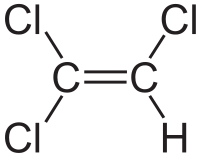
Photo from wikipedia
Trichloroethylene (TCE), a widely used organic solvent, is a common environmental pollutant. Increasing evidence indicates that maternal TCE exposure is associated with congenital cardiac defects, but the underlining mechanisms remain… Click to show full abstract
Trichloroethylene (TCE), a widely used organic solvent, is a common environmental pollutant. Increasing evidence indicates that maternal TCE exposure is associated with congenital cardiac defects, but the underlining mechanisms remain largely unknown. In this study, we revealed that TCE exposure significantly induced heart defects and dysfunctions in zebrafish embryos. Heart tissues were dissected and subjected to high throughput sequencing and qPCR to identify differentially expressed miRNAs and mRNAs. The effects of miRNA were further verified by microinjection of antagomir or agomir. Reactive Oxygen Species (ROS) and cell proliferation were measured by using dichlorodihydrofluorescein diacetate (DCFH-DA) and EdU staining, respectively. Our results showed that 19 miRNAs were downregulated whereas 48 miRNAs were upregulated in the heart of zebrafish embryos. The downregulation of miR-133a and the upregulation of miR-182 were further validated. Moreover, we found that miR-133a agomir significantly alleviated the TCE-induced heart defects while miR-133a antagomir mimicked the toxic effect of TCE on heart development. Furthermore, miR-133a agomir significantly counteracted TCE-induced ROS production and excessive cell proliferation in the heart of zebrafish embryos. In conclusion, our results indicate that miR-133a mediates TCE-induced ROS generation, leading to excessive cell proliferation and heart defects.
Journal Title: Chemosphere
Year Published: 2020
Link to full text (if available)
Share on Social Media: Sign Up to like & get
recommendations!